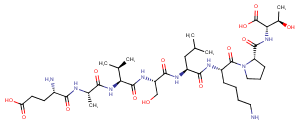Epsilon-V1-2
| Code | Size | Price |
|---|
| TAR-T35827-100mg | 100mg | Enquire | |||||||||||||||||||||||||||||||||||||||||||||||||||||||||||||||||||||||||||||||||||||||||||||||||
| Special offer! Add £1 to your order to get a TargetMol CCK-8 Kit. Read more here. | |||||||||||||||||||||||||||||||||||||||||||||||||||||||||||||||||||||||||||||||||||||||||||||||||||
Quantity:
| TAR-T35827-50mg | 50mg | Enquire | |||||||||||||||||||||||||||||||||||||||||||||||||||||||||||||||||||||||||||||||||||||||||||||||||
| Special offer! Add £1 to your order to get a TargetMol CCK-8 Kit. Read more here. | |||||||||||||||||||||||||||||||||||||||||||||||||||||||||||||||||||||||||||||||||||||||||||||||||||
Quantity:
Prices exclude any Taxes / VAT
Overview
Regulatory Status: RUO
Shipping:
cool pack
Storage:
-20℃
Images
Documents
Further Information
Bioactivity:
Protein kinase C (PKC ) is a calcium-independent, phospholipid- and diacylglycerol-dependent serine/threonine kinase involved in diverse signaling pathways, including those involved in neuronal signaling, cytoskeletal function, and inflammation.[1] PKC inhibitor peptide is a synthetic peptide corresponding to an amino acid sequence found in the amino terminal C2 domain of most mammalian forms of PKC .[2] It selectively and reversibly inhibits the translocation of PKC to intracellular membranes, blocking activation.[2] PKC inhibitor peptide is commonly used in cells to evaluate the role of PKC in various cellular responses.[3],[4],[5]
CAS:
182683-50-7
Formula:
C37H65N9O13
Molecular Weight:
844
Purity:
0.98
SMILES:
[H]N[C@@H](CCC(O)=O)C(N[C@H](C(N[C@@H](C(C)C)C(N[C@@H](CO)C(N[C@@H](CC(C)C)C(N[C@@H](CCCCN)C(N1CCC[C@H]1C(N[C@]([C@@H](C)O)([H])C(O)=O)=O)=O)=O)=O)=O)=O)C)=O
References
Schuster, D.J., Kitto, K.F., Overland, A.C., et al. Protein kinase C? is required for spinal analgesic synergy between delta opioid and alpha-2A adrenergic receptor agonist pairs. Journal of Neuroscience 33(33), 13538-13546 (2013).
Toker, A. Signaling through protein kinase C. Frontiers in Bioscience 3, d1134-d1147 (1998).
Thomspon, J.W., Dave, K.R., Saul, I., et al. Epsilon PKC increases brain mitochondrial SIRT1 protein levels via heat shock protein 90 following ischemic preconditioning in rats. PLoS One 8(9), 1-12 (2013).
Obis, T., Besalduch, N., Hurtado, E., et al. The novel protein kinase C epsilon isoform at the adult neuromuscular synapse: Location, regulation by synaptic activity-dependent muscle contraction through TrkB signaling and coupling to ACh release. Mol.Brain (2015).
Johnson, J.A., Gray, M.O., Chen, C.H., et al. A protein kinase C translocation inhibitor as an isozyme-selective antagonist of cardiac function. The Journal of Biological Chemisty 271(40), 24962-24966 (1996).



